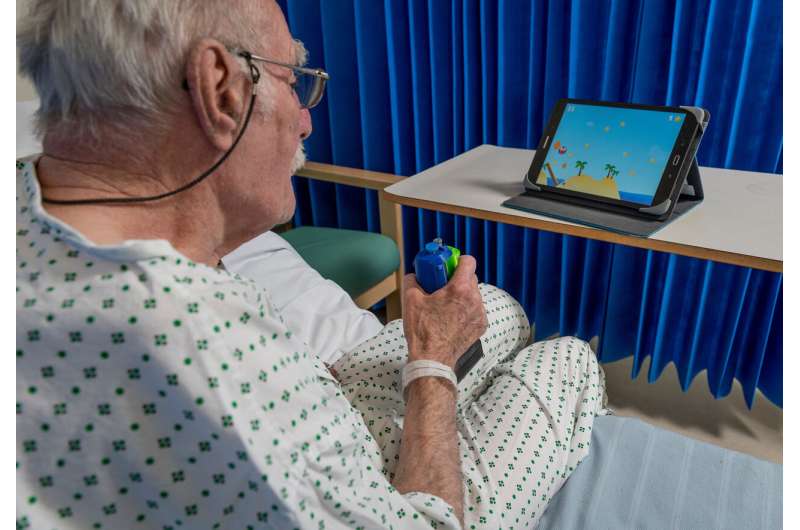
A rehabilitation device can increase the amount of arm exercises stroke patients do without professional supervision, according to a new study.
Over five million people in the UK live with arm weakness, with stroke damage accounting for one million people of those people.
The only intervention shown to improve arm function is repetitive, task-specific exercise but this is limited by the cost and availability of occupational therapists and physiotherapists.
The GripAble device, created by researchers at Imperial College London and clinicians at Imperial College Healthcare NHS Trust, consists of a lightweight electronic handgrip that interacts wirelessly with a standard PC tablet to enable the user to play arm-training games.
Using the GripAble
To use it, patients squeeze, turn, or lift the handgrip, and it vibrates in response to their performance whilst playing. The device uses a novel mechanism, which can detect the tiny flicker movements of severely paralyzed patients and channel them into controlling a computer game.
In a clinical trial of 30 patients, researchers from Imperial College London, the University of Southampton and Imperial College Healthcare NHS Trust found that the device enabled on average 104 upper limbs (UL) repetitions per day whereas conventional therapy achieved 15 UL repetitions per day. The study is published in Neurorehabilitation & Neural Repair.
Michelle Broderick, lead author of the study and Clinical Research Therapist in Stroke at Imperial College Healthcare NHS Trust, said: “Stroke is a major cause of arm weakness in the UK. It can significantly impact survivors’ lives making it hard for them to do routine daily tasks, limiting their independence. Previous studies have shown that repetitive exercise is vital for improving arm weakness, but this can be difficult due to resource constraints within healthcare settings, as well as the range of challenges faced by stroke survivors during their recovery, which can limit their ability to initiate or engage in independent exercise or rehabilitation activities.
“This study is the first to show that a rehabilitation device—GripAble—can achieve significant increases in the amount of exercise patients do compared to supervised therapy. Our findings suggest that a significant proportion of stroke survivors may potentially benefit from GripAble alongside conventional therapy. This could improve patient outcomes as well as easing pressure for the NHS in terms of infrastructure and resources.
“The next steps to fully determine GripAble’s impact is to assess the technology across a wider section of the population over a longer period of time.”
Dr. Paul Bentley co-author of the study and Clinical Director of the Imperial College Network of Excellence in Rehabilitation Technology at Imperial College London, added: “The findings from this clinical trial provide evidence that GripAble can be adopted to help further support stroke patients with severe arm weakness with their rehabilitation unsupervised.
“This could have big implications for the NHS, given that recovery from stroke is strongly influenced by exercise intensity. Our technology can be used by patients to continue with their physiotherapy outside of standard treatment and help with their recovery. The long-term aim of GripAble is that patients can use it outside of a clinical setting such as in their homes and communities and we are now working to further assess the device’s impact on clinical outcomes.”
Upper limb impairment
UL impairment is the most common physical side effect of stroke, with 60 percent of stroke survivors experiencing persistent UL weakness. Repetitive task- directed exercise improves long-term UL recovery, making this a key component of occupational therapy and physiotherapy following a stroke. However, this is limited by cost and availability of therapists.
In recent years, a growing number of rehabilitation technologies have emerged that boost the potential to provide cost-effective, intensive UL exercise. However, studies of rehabilitation technologies to date have typically focused on high-functioning cohorts of patients, which limits the applicability of their findings. The researchers wanted to see whether the GripAble device could be used to increase exercise dose of inpatient stroke survivors.
The team recruited 30 patients with UL weakness as a result of stroke from Charing Cross Hospital, part of Imperial College Healthcare NHS Trust, between September—December 2019. All participants were provided with the GripAble device and taught to use it in a single training session. The participants were then left to use the device without any supervision over eight days.
Clinical trial results
The researchers then compared the number of UL repetitions patients did as a result of the device with conventional therapy at the hospital. They found that 26 patients were able to use the device meaningfully with their affected UL. The device enabled 104 UL repetitions per day, whereas conventional therapy achieved 15 UL repetitions per day.
They also found that on average patients used the device for 26 minutes per day to do their UL exercises, in addition to 25 minutes daily conventional UL therapy, therefore doubling total exercise duration to 51 minutes, which is significantly greater than standard care.
After surveying the participants, they also found that 57 percent found the device easy to use and understand and 63 percent felt that the device promoted UL recovery.
Source: Read Full Article
